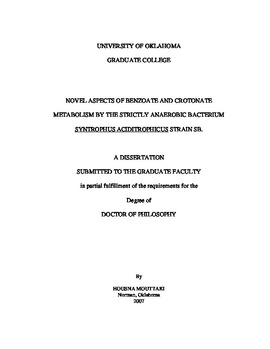| dc.contributor.advisor | McInerney, Michael, | en_US |
| dc.contributor.author | Mouttaki, Housna. | en_US |
| dc.date.accessioned | 2013-08-16T12:20:53Z | |
| dc.date.available | 2013-08-16T12:20:53Z | |
| dc.date.issued | 2007 | en_US |
| dc.identifier.uri | https://hdl.handle.net/11244/1250 | |
| dc.description.abstract | Although enzyme activities and metabolites detected in S. aciditrophicus indicated that benzoate was degraded by the pathway found in Rhodopseudomonas palustris, proteomic data detected the gene products homologous to that found in Thauera aromatica. Such observation supports the hypothesis of two routes for benzoate degradation exist in S. aciditrophicus, one involved in benzoate degradation to acetate and CO2 and the other involved in cyclohexane carboxylate formation from benzoate. | en_US |
| dc.description.abstract | S. aciditrophicus was shown to ferment benzoate to acetate and cyclohexane carboxylate via a dismutation process where reducing equivalents produced during benzoate oxidation to acetate and CO2 are used to reduce benzoate to cyclohexane carboxylate. The ability to ferment benzoate suggests that benzoate could serve as an electron acceptor if a suitable electron donor was present. To test whether benzoate can be respired, S. aciditrophicus was grown with crotonate and benzoate. Benzoate was stoichiometrically reduced to cyclohexane carboxylate while crotonate was oxidized to acetate. Cultures grown with [ring-13C]-benzoate and unlabeled crotonate formed ring-labeled 13C-cyclohexane carboxylate. No [13C]-labeled acetate was detected. The molar growth yield was 22.7 +/- 2.1 g (dry wt) cell per mol of crotonate compared to 14.0 +/- 0.1g per mol of crotonate when crotonate was used as a sole substrate. Furthermore, benzoate fermentation occurred only if traces amounts of crotonate were present. | en_US |
| dc.description.abstract | The metabolism of crotonate in the strictly anaerobic bacteria Syntrophus aciditrophicus was studied. S. aciditrophicus produced 1.4 +/- 0.24 moles of acetate and 0.16 +/- 0.02 moles of cyclohexane carboxylate per mole of crotonate degraded. [U- 13C] Crotonate was metabolized to [1, 2-13C] acetate and [1, 2, 3, 4, 5, 7-13C] cyclohexane carboxylate. Cultures grown with unlabeled crotonate and [13C] sodium bicarbonate formed [6-13C] cyclohexane carboxylate. Cyclohex-1-ene carboxylate, benzoate, pimelate, glutarate, 3-hydroxybutyrate, and acetoacetate were detected as intermediates. These are the same intermediates as that detected during syntrophic or fermentative benzoate metabolism by S. aciditrophicus . When S. aciditrophicus was grown with [1, 2- 13C] acetate and unlabeled crotonate, the m/z-15 of TMS-derivatized 3-hydroxybutyrate, acetoacetate, and glutarate each increased by +0, +2, and +4 mass units, and the m/z-15 of TMS-derivatized pimelate, cyclohex-1-ene carboxylate, benzoate, cyclohexane carboxylate, and 2-hydroxycyclohexane carboxylate each increased by +0, +2, +4 and +6 mass units. The data are consistent with a pathway for cyclohexane carboxylate formation involving the condensation of two-carbon units derived from crotonate degradation with CO2 addition, rather than the use of the intact four-carbon skeleton of crotonate. | en_US |
| dc.description.abstract | Fluorobenzoates and hydroxybenzoates were tested as substrates for S. aciditrophicus in order to detect potential intermediates of interest. The utilization of 3-fluorobenzoate allowed the detection of a metabolite, which had a mass ion increase of 2 units greater than the parent compound, or 3 or 4 units greater than the parent compound when deuterated water was used. These results were consistent with the formation of a fluorinated diene intermediate. The transient accumulation of benzoate when 2-hydroxybenzoate was the substrate showed that hydroxylation of the ring was not required for ring reduction. The metabolites detected with fluoro- and hydroxy-benzoates are consistent with the hypothesis that benzoyl-CoA reduction involves a two-electron reduction forming a diene intermediate, rather than a four- or six-electron reduction. | en_US |
| dc.description.abstract | Phototrophic and denitrifying bacteria couple the hydrolysis of two ATP molecules to reduce benzoyl-CoA to cyclohex-1,5-diene carboxyl-CoA. The use of such an energy intensive reaction by fermentative bacteria such as S. aciditrophicus has been questioned since it is not clear how net ATP synthesis would occur. Rather, a four- or six-electron reduction which thermodynamic calculations indicate is exergonic under standard conditions, or hydroxylation of the ring prior to its reduction have been proposed. | en_US |
| dc.description.abstract | Proteomic analysis of S. aciditrophicus grown with crotonate or crotonate and benzoate allowed the identification of gene products involved in benzoate metabolism. Two benzoyl-CoA ligases and a possible novel benzoyl-CoA reductase, a tungsten/molybdenum-containing aldehyde ferredoxin oxidoreductase associated with heterodisulfide reductase components similar to the benzoate-induced proteins found in G. metallireducens were identified. Cyclohex-1,5-diene carboxyl-CoA hydratase and the enzymes needed to form 3-hydroxypimelyl-CoA from the diene were also detected. The detection of subunits of ATP synthase, cytoplasmic and periplasmic formate dehydrogenases, a sodium-translocating glutaconyl-CoA, and sodium-driven membrane-bound NADH:ferredoxin oxidoreductase indicates that S. aciditrophicus has the potential to create and use both sodium and proton gradients. ATP synthesis from acetyl-CoA appears to occur by an archaeal-like acetyl-CoA synthetase (ADP-forming) rather than the typical bacterial phosphotransacetylaseacetate kinase system. | en_US |
| dc.format.extent | xxii, 235 leaves : | en_US |
| dc.subject | Biology, Microbiology. | en_US |
| dc.subject | Anaerobic bacteria. | en_US |
| dc.subject | Crotonic acid. | en_US |
| dc.subject | Benzoates Metabolism. | en_US |
| dc.title | Novel aspects of benzoate and crotonate metabolism by the strictly anaerobic bacterium Syntrophus aciditrophicus strain SB. | en_US |
| dc.type | Thesis | en_US |
| dc.thesis.degree | Ph.D. | en_US |
| dc.thesis.degreeDiscipline | Department of Microbiology and Plant Biology | en_US |
| dc.note | Source: Dissertation Abstracts International, Volume: 68-07, Section: B, page: 4262. | en_US |
| dc.note | Adviser: Michael McInerney. | en_US |
| ou.identifier | (UMI)AAI3273886 | en_US |
| ou.group | College of Arts and Sciences::Department of Microbiology and Plant Biology | |
